Characterizing and Implementing the Hamamatsu C12880MA Mini-Spectrometer for Near-Surface Reflectance Measurements of Inland Waters
Abstract
:1. Introduction
2. Ground-Based Sensor Network for Near-Surface Sensing of Inland Waters
3. Materials and Methods
3.1. The Optical Sensor
3.2. Hardware and Software Implementation
3.3. Measurement Setup
4. Results
4.1. Sensor Characterization in the Laboratory
4.2. Field Test
4.2.1. Field Test at Lakes
4.2.2. Field Test at a Freshwater Mesocosm Facility
5. Discussion and Conclusions
Supplementary Materials
Author Contributions
Funding
Institutional Review Board Statement
Informed Consent Statement
Data Availability Statement
Acknowledgments
Conflicts of Interest
References
- Dudgeon, D.; Arthington, A.H.; Gessner, M.Q.; Kawabata, Z.; Knowler, D.J.; Lévêque, C.; Naiman, R.J.; Prieur-Richard, A.H.; Soto, D.; Stiassny, M.L.J.; et al. Freshwater biodiversity: Importance, threats, status and conservation challenges. Biol. Rev. 2006, 8, 163–182. [Google Scholar] [CrossRef] [PubMed]
- Kummu, M.; de Moel, H.; Ward, P.J.; Varis, O. How close do we live to water? A global analysis of population distance to freshwater bodies. PLoS ONE 2011, 6, e20578. [Google Scholar] [CrossRef] [PubMed]
- Smith, V.H.; Joye, S.B.; Howarth, R.W. Eutrophication of freshwater and marine ecosystems. Limnol. Oceanogr. 2006, 51, 351–355. [Google Scholar] [CrossRef]
- Paerl, H.W.; Otten, T.G. Harmful cyanobacterial blooms: Causes, consequences and controls. Microb. Ecol. 2013, 65, 995–1010. [Google Scholar] [CrossRef]
- Palmer, S.C.J.; Kutser, T.; Hunter, P.D. Remote sensing of inland waters: Challenges, progress and future directions. Remote Sens. Environ. 2015, 157, 1–8. [Google Scholar] [CrossRef]
- Topp, S.N.; Pavelsky, T.M.; Jensen, D.; Simard, M.; Ross, M.R.V. Research Trends in the Use of Remote Sensing for Inland Water Quality Science: Moving Towards Multidisciplinary Applications. Water 2020, 12, 169. [Google Scholar] [CrossRef]
- Lausch, A.; Bannehr, L.; Berger, S.A.; Borg, E.; Bumberger, J.; Hacker, J.M.; Heege, T.; Hupfer, M.; Jung, A.; Kuhwald, K.; et al. Monitoring Water Diversity and Water Quality with Remote Sensing and Traits. Remote Sens. 2024, 16, 2425. [Google Scholar] [CrossRef]
- Toming, K.; Kutser, T.; Laas, A.; Sepp, M.; Paavel, B.; Nõges, T. First Experiences in Mapping Lake Water Quality Parameters with Sentinel-2 MSI Imagery. Remote Sens. 2016, 8, 640. [Google Scholar] [CrossRef]
- Ogashawara, I.; Kiel, C.; Jechow, A.; Kohnert, K.; Ruhtz, T.; Grossart, H.-P.; Hölker, F.; Nejstgaard, J.C.; Berger, S.A.; Wollrab, S. The Use of Sentinel-2 for Chlorophyll-a Spatial Dynamics Assessment: A Comparative Study on Different Lakes in Northern Germany. Remote Sens. 2021, 13, 1542. [Google Scholar] [CrossRef]
- Kudela, R.M.; Palacios, S.L.; Austerberry, D.C.; Accorsi, E.K.; Guild, L.S.; Torres-Perez, J. Application of hyperspectral remote sensing to cyanobacterial blooms in inland waters. Remote Sens. Environ. 2015, 167, 196–205. [Google Scholar] [CrossRef]
- Guanter, L.; Kaufmann, H.; Segl, K.; Foerster, S.; Rogass, C.; Chabrillat, S.; Kuester, T.; Hollstein, A.; Rossner, G.; Chlebek, C.; et al. The EnMAP Spaceborne Imaging Spectroscopy Mission for Earth Observation. Remote Sens. 2015, 7, 8830–8857. [Google Scholar] [CrossRef]
- Krutz, D.; Müller, R.; Knodt, U.; Günther, B.; Walter, I.; Sebastian, I.; Säuberlich, T.; Reulke, R.; Carmona, E.; Eckardt, A.; et al. The Instrument Design of the DLR Earth Sensing Imaging Spectrometer (DESIS). Sensors 2019, 19, 1622. [Google Scholar] [CrossRef] [PubMed]
- Göritz, A.; Berger, S.A.; Gege, P.; Grossart, H.-P.; Nejstgaard, J.C.; Riedel, S.; Röttgers, R.; Utschig, C. Retrieval of Water Constituents from Hyperspectral In-Situ Measurements under Variable Cloud Cover—A Case Study at Lake Stechlin (Germany). Remote Sens. 2018, 10, 181. [Google Scholar] [CrossRef]
- Marce, R.; George, G.; Buscarinu, P.; Deidda, M.; Dunalska, J.; Eyto, E.; Flaim, G.; Grossart, H.P.; Istvanovics, V.; Lenhardt, M.; et al. Automatic high frequency monitoring for improved lake and reservoir management. Environ. Sci. Technol. 2016, 50, 10780–10794. [Google Scholar] [CrossRef] [PubMed]
- Mobley, C. Estimation of the Remote-Sensing Reflectance from Above-Surface Measurements. Appl. Opt. 1999, 38, 7442–7455. [Google Scholar] [CrossRef]
- Randolph, K.; Wilson, J.; Tedesco, L.; Li, L.; Lani Pascual, D.; Soyeux, E. Hyperspectral remote sensing of cyanobacteria in turbid productive water using optically active pigments, chlorophyll a and phycocyanin. Remote Sens. Environ. 2008, 112, 4009–4019. [Google Scholar] [CrossRef]
- Velasco, A.; Ferrero, R.; Gandino, F.; Montrucchio, B.; Rebaudengo, M. A Mobile and Low-Cost System for Environmental Monitoring: A Case Study. Sensors 2016, 16, 710. [Google Scholar] [CrossRef]
- Liu, W.; Baret, F.; Gu, X.; Tong, Q.; Zheng, L.; Zhang, B. Relating soil surface moisture to reflectance. Remote Sens. Environ. 2002, 81, 238–246. [Google Scholar]
- Pacheco-Labrador, J.; Martín, M.P. Characterization of a Field Spectroradiometer for Unattended Vegetation Monitoring. Key Sensor Models and Impacts on Reflectance. Sensors 2015, 15, 4154–4175. [Google Scholar] [CrossRef]
- Kantzas, E.P.; McGonigle, A.J.S. Ground Based Ultraviolet Remote Sensing of Volcanic Gas Plumes. Sensors 2008, 8, 1559–1574. [Google Scholar] [CrossRef]
- Kumar, P.; Morawska, L.; Martani, C.; Biskos, G.; Neophytou, M.; Di Sabatino, S.; Bell, M.; Norford, L.; Britter, R. The rise of low-cost sensing for managing air pollution in cities. Environ. Int. 2015, 75, 199–205. [Google Scholar] [CrossRef] [PubMed]
- McGonigle, A.J.S.; Wilkes, T.C.; Pering, T.D.; Willmott, J.R.; Cook, J.M.; Mims, F.M.; Parisi, A.V. Smartphone Spectrometers. Sensors 2018, 18, 223. [Google Scholar] [CrossRef] [PubMed]
- Moron-Lopez, J.; Rodriguez-Sanchez, M.C.; Carreno, F.; Vaquero, J.; Pompa-Pernia, A.G.; Mateos-Fernandez, M.; Aguilar, J.A.P. Implementation of Smart Buoys and Satellite-Based Systems for the Remote Monitoring of Harmful Algae Bloom in Inland Waters. IEEE Sens. J. 2020, 21, 6990–6997. [Google Scholar] [CrossRef]
- Brentrup, J.A.; Williamson, C.E.; Colom-Montero, W.; Eckert, W.; De Eyto, E.; Grossart, H.-P.; Huot, Y.; Isles, P.D.F.; Knoll, L.B.; Leach, T.H.; et al. The potential of high-frequency profiling to assess vertical and seasonal patterns of phytoplankton dynamics in lakes: An extension of the Plankton Ecology Group (PEG) model. Inland Waters 2016, 6, 565–580. [Google Scholar] [CrossRef]
- Free, G.; Bresciani, M.; Pinardi, M.; Giardino, C.; Alikas, K.; Kangro, K.; Rõõm, E.-I.; Vaičiūtė, D.; Bučas, M.; Tiškus, E.; et al. Detecting Climate Driven Changes in Chlorophyll-a Using High Frequency Monitoring: The Impact of the 2019 European Heatwave in Three Contrasting Aquatic Systems. Sensors 2021, 21, 6242. [Google Scholar] [CrossRef]
- Bresciani, M.; Pinardi, M.; Free, G.; Luciani, G.; Ghebrehiwot, S.; Laanen, M.; Peters, S.; Della Bella, V.; Padula, R.; Giardino, C. The Use of Multisource Optical Sensors to Study Phytoplankton Spatio-Temporal Variation in a Shallow Turbid Lake. Water 2020, 12, 284. [Google Scholar] [CrossRef]
- Peters, S.; Laanen, M.; Groetsch, P.; Ghezehegn, S.; Poser, K.; Hommersom, A.; DeReus, E.; Spaias, L. WISPstation: A New Autonomous above Water Radiometer System. In Proceedings of the Ocean Optics XXIV Conference, Dubrovnik, Croatia, 7–12 October 2018. [Google Scholar] [CrossRef]
- Pahlevan, N.; Smith, B.; Alikas, K.; Anstee, J.; Barbosa, C.; Binding, C.; Bresciani, M.; Cremella, B.; Giardino, C.; Gurlin, D.; et al. Simultaneous retrieval of selected optical water quality indicators from Landsat-8, Sentinel-2, and Sentinel-3. Remote Sens. Environ. 2022, 270, 112860. [Google Scholar] [CrossRef]
- Ogashawara, I.; Jechow, A.; Kiel, C.; Kohnert, K.; Berger, S.A.; Wollrab, S. Performance of the Landsat 8 Provisional Aquatic Reflectance Product for Inland Waters. Remote Sens. 2020, 12, 2410. [Google Scholar] [CrossRef]
- Bumberger, J.; Bannehr, L.; Berger, S.A.; Dörnhöfer, K.; Fritz, C.; Gerasch, B.; Heege, T.; Herzog, M.; Hieronymi, M.; Hupfer, M.; et al. Inland Water Remote Sensing Validation Campaign 2017 [Dataset Bibliography]; PANGAEA: Bremen, Germany, 2023. [Google Scholar]
- Bumberger, J.; Berger, S.A.; Dörnhöfer, K.; Fritz, C.; Gerasch, B.; Hieronymi, M.; Hupfer, M.; Jechow, A.; Jordan, S.; Klinger, P.; et al. Intercalibration Campaign Lake Süßer See (Germany) in Saxony-Anhalt during the Inland Water Remote Sensing Validation Campaign 2017 [Dataset Publication Series]; PANGAEA: Bremen, Germany, 2023. [Google Scholar] [CrossRef]
- Berger, S.A.; Bumberger, J.; Dörnhöfer, K.; Friese, K.; Herzog, M.; Jechow, A.; Klinger, P.; Korman, B.; Lentz, M.; Moll, V.; et al. Results of lake water analysis from Kelbra Reservoir in Saxony-Anhalt during the Inland Water Remote Sensing Validation Campaign 2017 [Dataset Publication Series]; PANGAEA: Bremen, Germany, 2023. [Google Scholar] [CrossRef]
- Jechow, A.; Schreck, G.; Kyba, C.; Berger, S.A.; Bistarelli, L.T.; Bodenlos, M.; Gessner, M.O.; Grossart, H.P.; Kupprat, F.; Nejstgaard, J.C.; et al. Design and implementation of an illumination system to mimic skyglow at ecosystem level in a large-scale lake enclosure facility. Sci. Rep. 2021, 11, 23478. [Google Scholar] [CrossRef]
- López-Pérez, G.; González-Arjona, D.; Roldán González, E.; Román-Hidalgo, C. Design of a Portable and Reliable Fluorimeter with High Sensitivity for Molecule Trace Analysis. Chemosensors 2023, 11, 389. [Google Scholar] [CrossRef]
- Sosa-Herrera, J.A.; Alvarez-Jarquin, N.; Cid-Garcia, N.M.; López-Araujo, D.J.; Vallejo-Pérez, M.R. Automated Health Estimation of Capsicum annuum L. Crops by Means of Deep Learning and RGB Aerial Images. Remote Sens. 2022, 14, 4943. [Google Scholar] [CrossRef]
- Troscianko, J. OSpRad: An open-source, low-cost, high-sensitivity spectroradiometer. J. Exp. Biol. 2023, 226, jeb245416. [Google Scholar] [CrossRef] [PubMed]
- Schmidt, L.; Schäfer, D.; Geller, J.; Lünenschloss, P.; Palm, B.; Rinke, K.; Rebmann, C.; Rode, M.; Bumberger, J. System for automated Quality Control (SaQC) to enable traceable and reproducible data streams in environmental science. Environ. Model. Softw. 2023, 169, 105809. [Google Scholar] [CrossRef]
- Tunens, G.; Einbergs, E.; Laganovska, K.; Zolotarjovs, A.; Vilks, K.; Skuja, L.; Smits, K. Optical fiber-based open source low cost portable spectrometer system. HardwareX 2024, 18, e00530. [Google Scholar] [CrossRef] [PubMed]



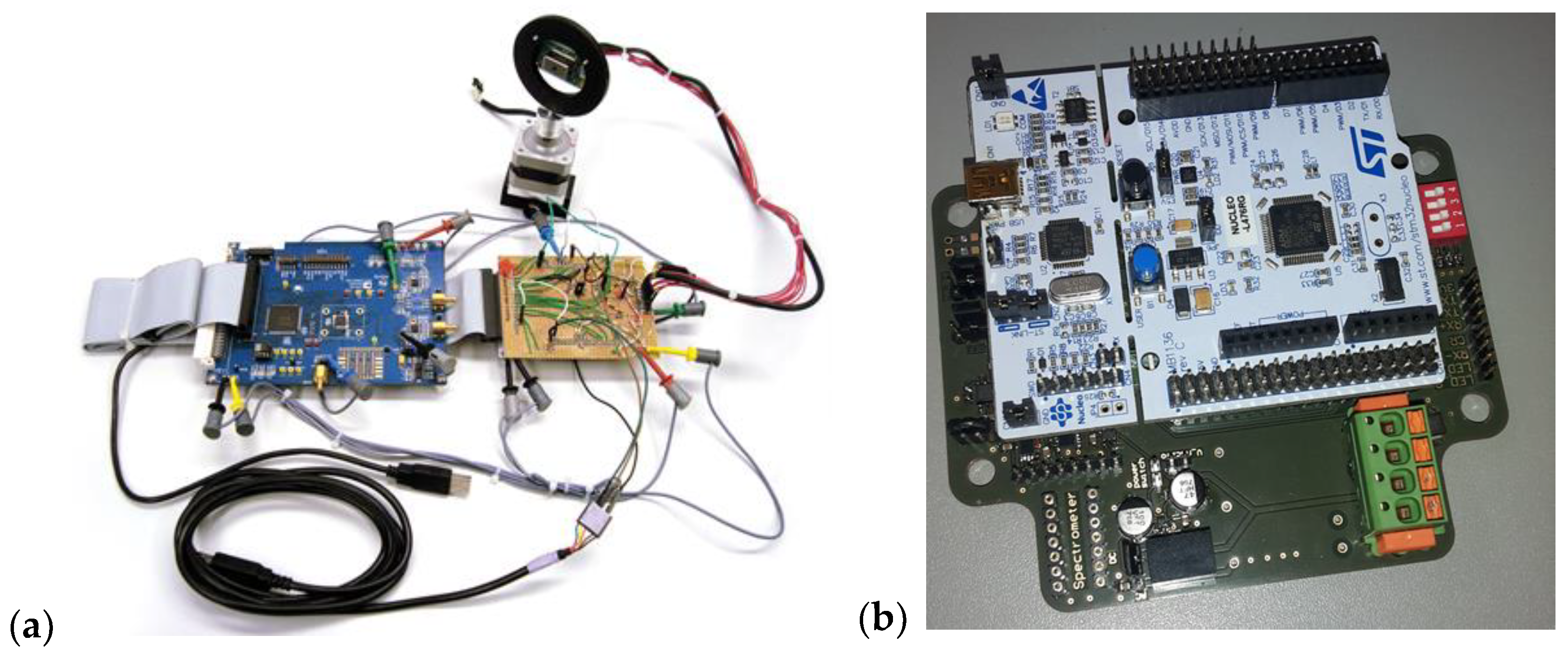
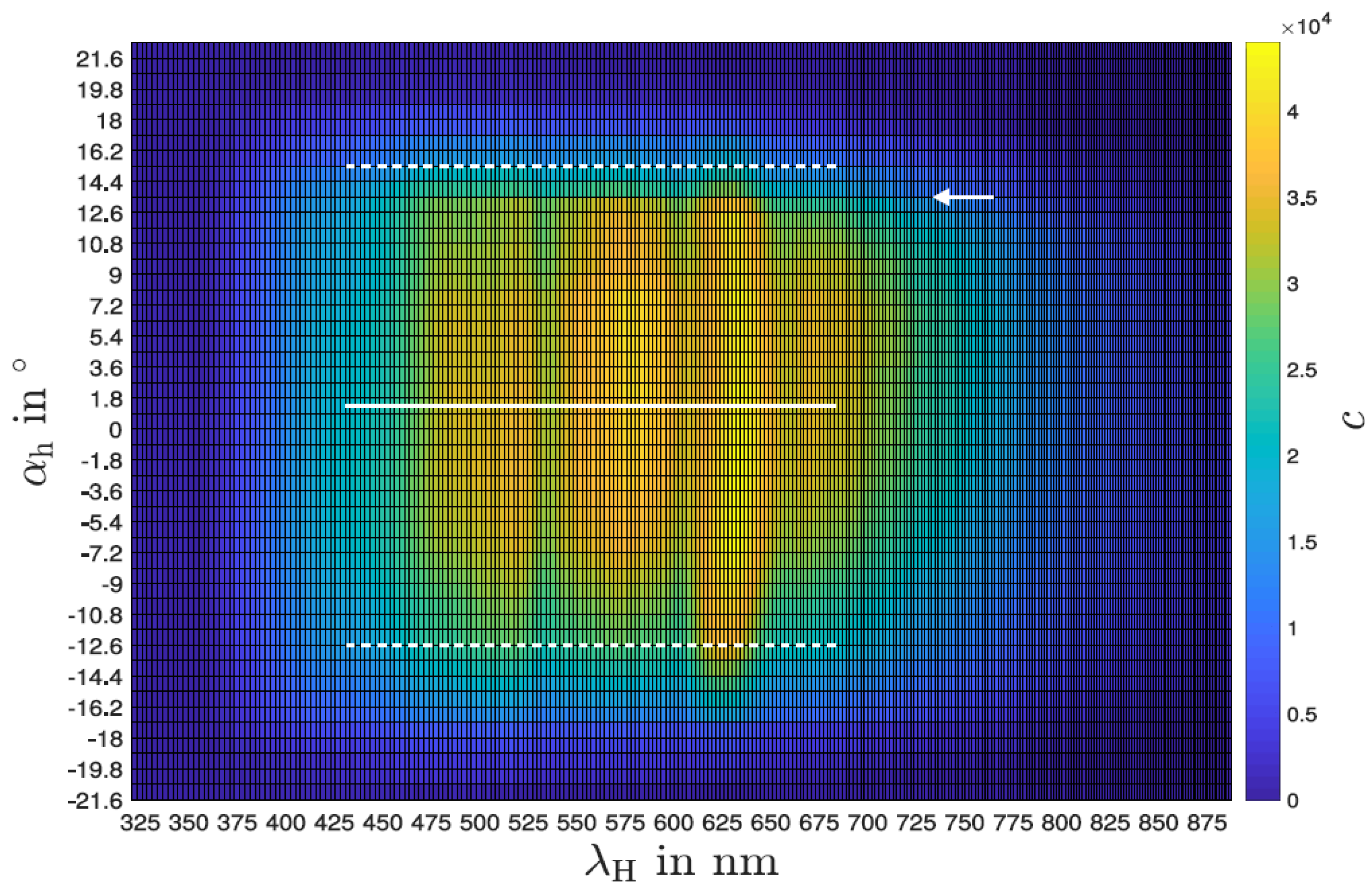
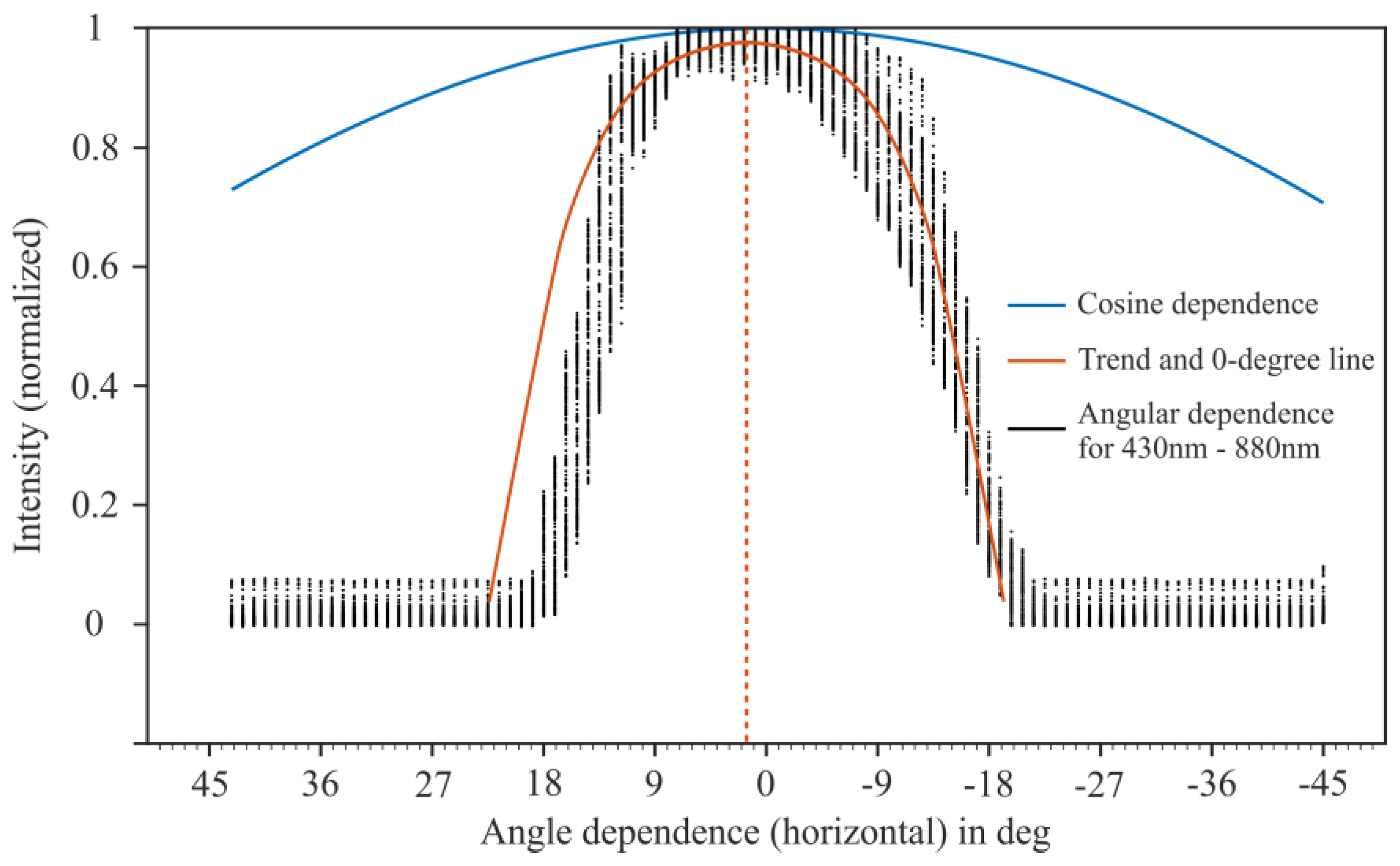
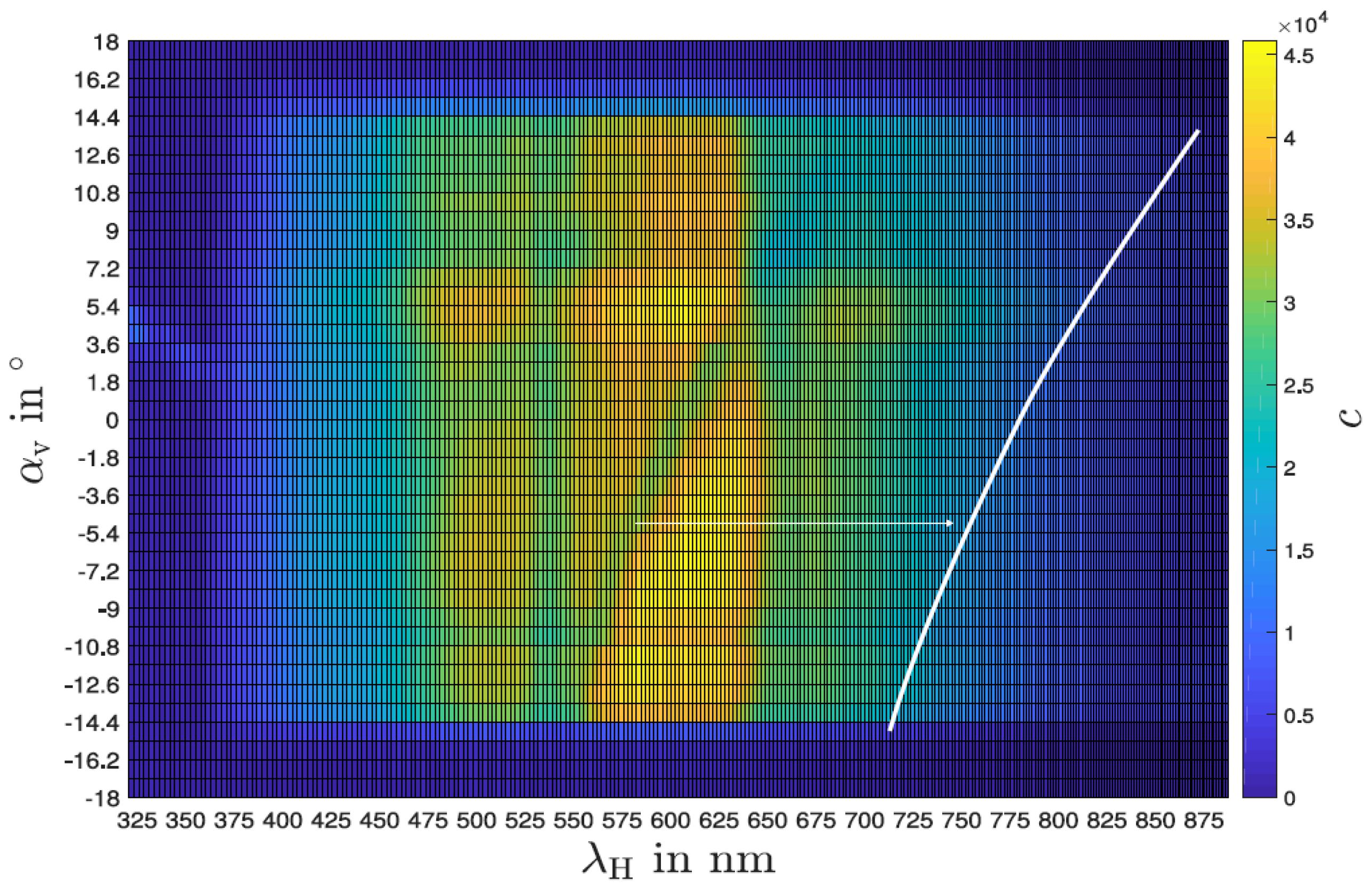
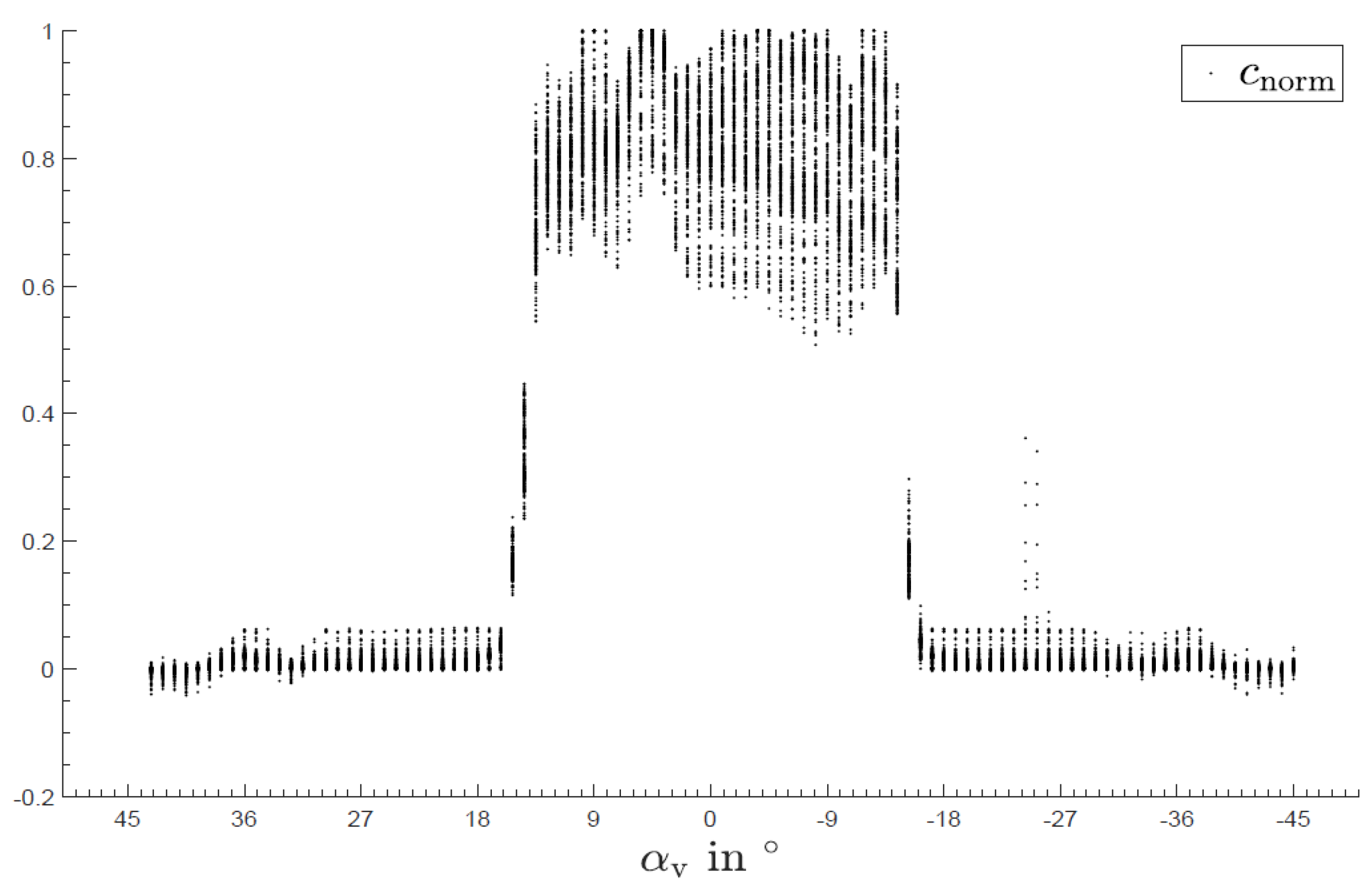


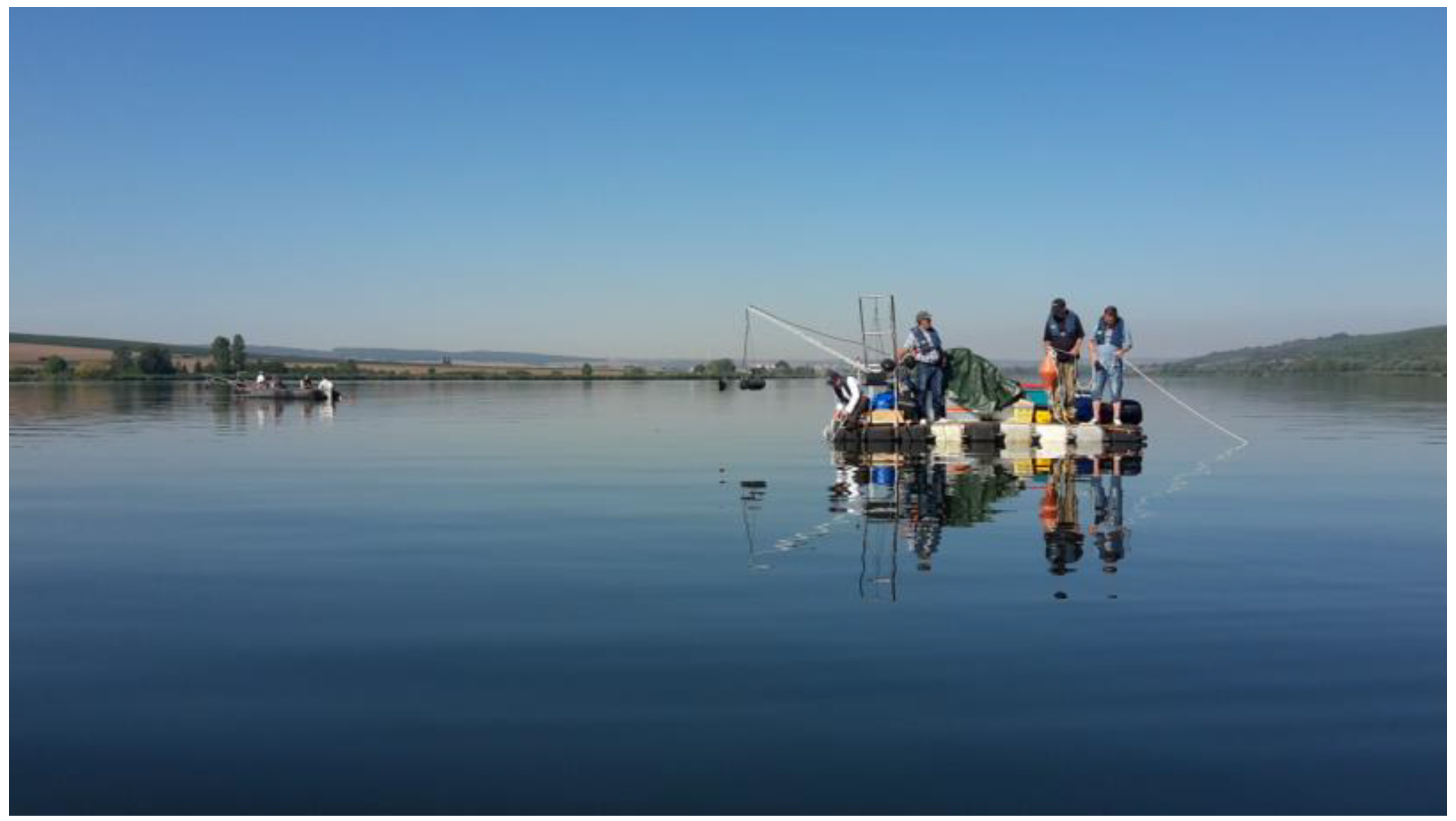
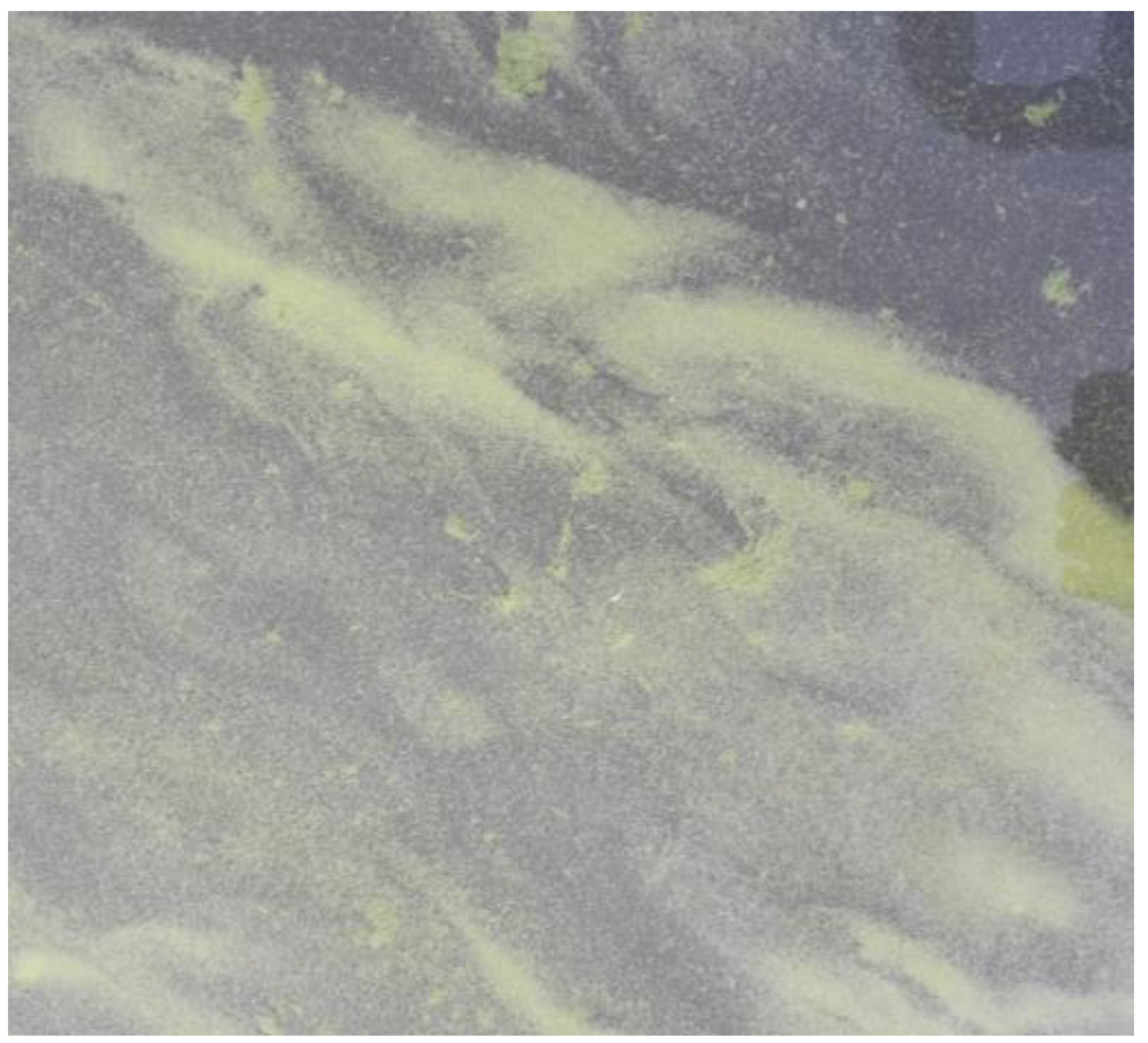

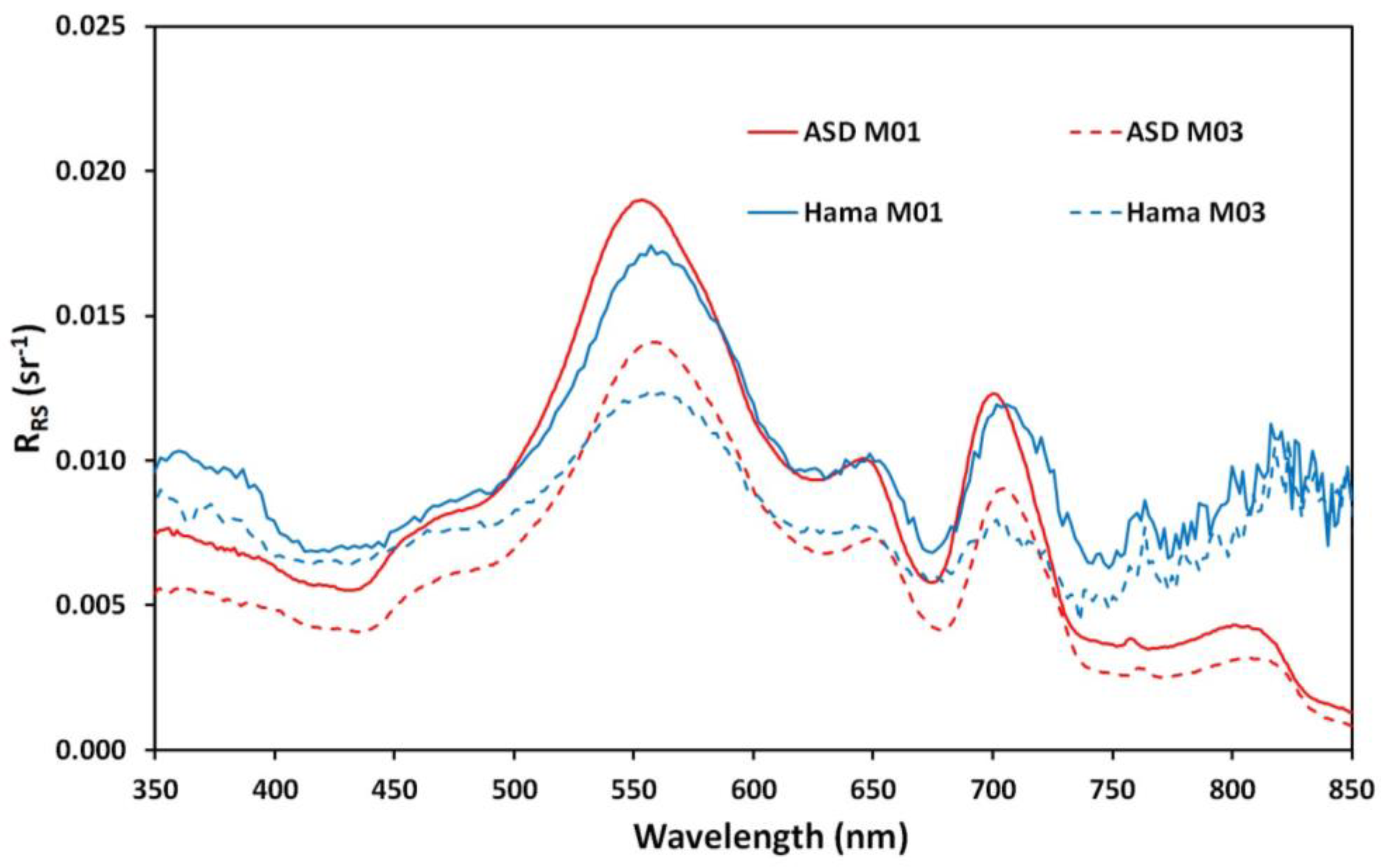


| Symbol | Name | I/O | A/D |
|---|---|---|---|
| CLK | Clock | I | D |
| ST | Start | I | D |
| TRG | Trigger | O | D |
| EOS | End of scan | O | D |
| Video | Video output | O | A |
| Property | ASD Field Spec 4 | Hamamatsu |
|---|---|---|
| spectral range | 350–2500 nm | 350–850 nm |
| spectral resolution (VIS) | 3 nm | 12 nm |
| spectral channels | 2151 | 288 |
| calibration | yes | no |
| interface | fiber optics | glass window 1 |
| price | ca. 50,000 € | ca. 400 € |
Disclaimer/Publisher’s Note: The statements, opinions and data contained in all publications are solely those of the individual author(s) and contributor(s) and not of MDPI and/or the editor(s). MDPI and/or the editor(s) disclaim responsibility for any injury to people or property resulting from any ideas, methods, instructions or products referred to in the content. |
© 2024 by the authors. Licensee MDPI, Basel, Switzerland. This article is an open access article distributed under the terms and conditions of the Creative Commons Attribution (CC BY) license (https://creativecommons.org/licenses/by/4.0/).
Share and Cite
Jechow, A.; Bumberger, J.; Palm, B.; Remmler, P.; Schreck, G.; Ogashawara, I.; Kiel, C.; Kohnert, K.; Grossart, H.-P.; Singer, G.A.; et al. Characterizing and Implementing the Hamamatsu C12880MA Mini-Spectrometer for Near-Surface Reflectance Measurements of Inland Waters. Sensors 2024, 24, 6445. https://doi.org/10.3390/s24196445
Jechow A, Bumberger J, Palm B, Remmler P, Schreck G, Ogashawara I, Kiel C, Kohnert K, Grossart H-P, Singer GA, et al. Characterizing and Implementing the Hamamatsu C12880MA Mini-Spectrometer for Near-Surface Reflectance Measurements of Inland Waters. Sensors. 2024; 24(19):6445. https://doi.org/10.3390/s24196445
Chicago/Turabian StyleJechow, Andreas, Jan Bumberger, Bert Palm, Paul Remmler, Günter Schreck, Igor Ogashawara, Christine Kiel, Katrin Kohnert, Hans-Peter Grossart, Gabriel A. Singer, and et al. 2024. "Characterizing and Implementing the Hamamatsu C12880MA Mini-Spectrometer for Near-Surface Reflectance Measurements of Inland Waters" Sensors 24, no. 19: 6445. https://doi.org/10.3390/s24196445








